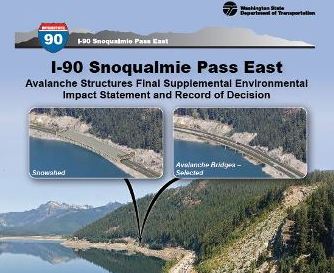Provisions of the Moving Ahead for Progress in the 21st Century Act (MAP-21) that allow environmental impact statements and record of decision documents to be combined for transportation projects have achieved significant time savings for Washington State DOT, according to the agency.
Background
The authority to issue one combined document have saved approximately 60 days to 90 days for the first two projects for which the agency used it, state officials report.
The authority was enacted as a streamlining provision under Section 1319 of MAP-21. In addition, the law authorized use of errata pages rather than a separate standalone final EIS if only minor comments are received on a draft EIS.
The provisions of MAP-21 were aimed at cutting the time required to process environmental documents for transportation projects.
WSDOT has published two combined FEIS/RODs under the new law: a Final Supplemental EIS and Record of Decision for the I-90 Snoqualmie Pass East project, and a Final Supplemental EIS and Record of Decision for the SR 167 Puyallup River Bridge project, according to WSDOT Policy Branch Manager Carol Lee Roalkvam.
For both projects, the combined EIS/ROD eliminated one round of document circulation and streamlined the cooperating agency and legal review. Each project saved approximately two to three months’ time, she said.
Additionally, the I-90 project team used the related streamlining measure which allows for a Draft EIS and errata page to suffice for a final EIS.
The I-90 team noted that the new processes used together took less time that it would have taken to prepare an Environmental Assessment/Finding of No Significant, according to Roalkvam. In one year, the team went from notice of intent, to Draft Supplemental EIS, to Final EIS/ROD.
“Many state DOTs are searching for examples of quality environmental documents,” Roalkvam said. “While every project is unique, I encourage state DOTs to look at the way the I-90 team applied the MAP-21 streamlining provision and the abbreviated FEIS format to prepare a concise, complete and readable document.”

Washington State DOT combines final EIS, Record of Decision for I-90 Project. Photo: WSDOT
Combined FEIS and ROD
Prior to MAP-21, FHWA and FTA were required by their own regulations and Council on Environmental Quality regulations to provide a waiting period of at least 30 days between publication of the FEIS and issuance of the ROD.
Section 1319(b) of MAP-21 overrode that requirement. It directs the lead agency to issue the FEIS and ROD as a single document “to the maximum extent practicable,” unless one of the following conditions is met:
- the FEIS makes “substantial changes to the proposed action that are relevant to environmental or safety concerns” or
- “there are significant new circumstances or information relevant to environmental concerns and that bear on the proposed action or the impacts of the proposed action.”
FHWA and FTA issued interim guidance implementing Section 1319 on Jan. 14, 2013. The interim guidance calls for a case-by-case determination as to whether it is “practicable” to issue a combined FEIS and ROD. The guidance also directs FHWA Division Offices and FTA Regional Offices to consult with headquarters before issuing a combined FEIS/ROD.
‘Errata Pages’ Format for FEIS
MAP 21 also clarified that the lead agency can issue an FEIS that consists of “errata pages” — rather than a complete, stand-alone document — if the agency received only “minor comments” on the Draft EIS.
This flexibility existed under the CEQ regulations even before the enactment of MAP-21. Section 1319(a) confirms that this format is acceptable.
It also requires that errata pages “(1) cite the sources, authorities, or reasons that support the position of the agency” and “(2) if appropriate, indicate the circumstances that would trigger agency reappraisal or further response.”
In the Jan. 14 guidance, FHWA and FTA described the information that should be included in errata pages, and confirmed that this documentation must undergo the legal sufficiency review required for an FEIS under 23 CFR 771.125.
Additional information is available from Carol Lee Roalkvam, Policy Branch Manager, WSDOT, at [email protected].

